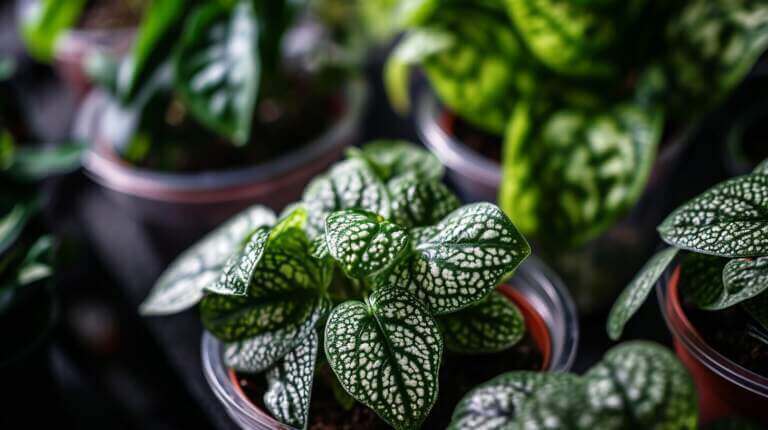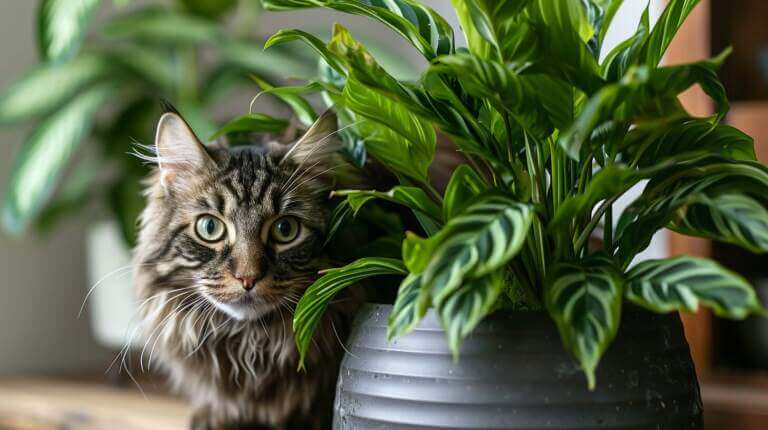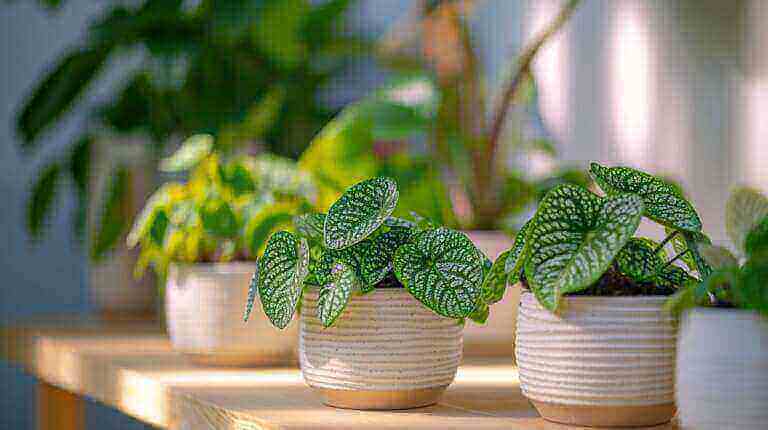Why Is My Snake Plant leaves Curling? Cause & Solution for Curled Leaves on Sansevieria
This well liked indoor houseplant called Snake plant is actually hardy, but signs of curling leaves on your snake plant can be cause for concern. This comprehensive guide reveals the main causes and solutions for snake plant leaves that curl inward and turn yellow.
Overwatering is one of the most common reasons why snake plant leaves are curling. Too much water prevents the roots from absorbing enough nutrients and oxygen. Underwatering can also cause leaves to droop and curl inward. Snake plants need consistent moisture but not soggy soil. We’ll explore the ideal watering schedule and techniques to save the plant.
Inadequate light, transplant shock, and extreme temperatures are other common causes of your snake plant’s curling leaves. Snake plants prefer bright, indirect light and temperatures between 65-80 degrees Fahrenheit. We’ll discuss warning signs like yellowing foliage and how to adjust lighting and placement to nurture the plant back to health.
Additionally, pests and diseases like southern blight and fungal infections can infect the plant and cause the leaves to curl inwards. We’ll cover how to check for root rot, treat infected leaves, and repot your snake plant to fix this issue. With the proper care, your snake plant can thrive for years to come!
Key Takeaways
- Improper watering practices, such as underwatering or overwatering, can cause the plant leaf to curl or droopy.
- Snake plants require adequate lighting, but excessive sunlight can scorch their leaves.
- Maintaining moderate to high humidity levels and using a well-draining soil mix can help prevent leaf curling and promote healthy growth.
- Regular propagation and avoiding heavy soils that retain too much moisture are also important for maintaining healthy snake plants.
Common Causes of Snake Plant Leaf Curling
One common cause of snake plant leaf curling is improper watering practices, which can lead to dehydration and stress on the plant. Snake plants, also known as Sansevieria, are hardy succulents that are native to arid regions of West Africa. These plants have adapted to survive in low-water conditions, making them well-suited for indoor environments with minimal maintenance. However, when it comes to watering snake plants, finding the right balance is crucial.
Underwatering is a common issue that can cause snake plant leaves to begin to curl. When the plant doesn’t receive enough water, it will respond by conserving moisture, resulting in curled leaves. To prevent this, it’s important to water your snake plant thoroughly, allowing the water to soak through the soil and drain out of the pot’s drainage holes. Remember to wait until the soil is completely dry before watering again.
On the other hand, overwatering can also cause leaf curling in snake plants. When the roots are constantly saturated, they can become waterlogged, leading to root rot and stress on the plant. To avoid overwatering, make sure to allow the soil to dry out between waterings. It’s best to err on the side of underwatering rather than overwatering, as snake plants are more tolerant of drought than excessive moisture.
Signs and Symptoms of Curled Leaves on Sansevieria
Understanding the signs and symptoms of curled leaves on Sansevieria can provide valuable insights into the potential causes and necessary steps for addressing this issue. Diagnosing leaf curling in snake plants involves closely observing the plant and considering various factors such as environmental conditions, pest infestations, and cultural practices. By identifying the underlying cause, appropriate treatment options for curled snake plant leaves can be implemented to restore the plant’s health.
The table below summarizes common signs and symptoms of curled leaves on Sansevieria, along with their potential causes and treatment options:
| Signs and Symptoms | Potential Causes | Treatment Options |
|---|---|---|
| Curling or wilting | Overwatering | Adjust watering frequency and allow soil to dry between waterings |
| Underwatering | Increase watering frequency and ensure proper drainage | |
| Low humidity | Mist the leaves regularly or use a humidifier | |
| Temperature stress | Maintain consistent temperatures and avoid drafts | |
| Pest infestation | Treat with appropriate insecticides or natural remedies | |
| Yellowing or browning | Excessive sunlight | Move the plant to a location with indirect or filtered light |
| Nutrient deficiency | Fertilize regularly with a balanced fertilizer | |
| Root rot | Repot the plant in well-draining soil and trim affected roots |
How to Correctly Water Your Snake Plant
To ensure optimal growth and health, it is crucial to water your snake plant correctly, considering factors such as soil moisture levels, pot size, and watering frequency. Proper watering techniques are essential for the well-being of your snake plant.
Overwatering can lead to root rot and other issues, while underwatering can cause the leaves to wilt and become dry.
When watering your snake plant, checking the soil moisture levels is important. The top inch of soil should be dry before watering again. This will prevent overwatering and ensure that the roots have enough oxygen to thrive. Additionally, the size of the pot plays a role in watering frequency. Smaller pots dry out faster, so they may require more frequent watering compared to larger pots.
Signs of overwatering include yellowing leaves, mushy stems, and a foul odor. If you notice these signs, it is important to adjust your watering routine. Allow the soil to dry out completely before watering again. On the other hand, if your snake plant’s leaves are wrinkled and dry, it may be a sign of underwatering. In this case, increase the watering frequency, making sure not to overdo it.
Providing Adequate Lighting for Your Sansevieria
In order to promote healthy growth and prevent issues such as leaf discoloration and elongation, it is essential to provide adequate or enough lighting for your Sansevieria by placing it in a well-lit area with indirect sunlight.
Sansevieria, also known as Snake Plant or Mother-in-law’s Tongue, is a popular indoor plant due to its low maintenance and air purifying properties. However, improper lighting can lead to various leaf problems, including curling.
To maximize growth and prevent leaf curling, it is important to understand the lighting requirements of your Sansevieria. Ideally, it should be placed in a location with bright, indirect sunlight. Direct sunlight can scorch the leaves, while insufficient light can cause weak growth and leaf problems.
If you notice that your Sansevieria’s leaves are curling, it could be a sign of inadequate lighting. Try moving the plant to a brighter spot with indirect sunlight to troubleshoot this issue. If natural light is limited, you can supplement it with artificial light, such as fluorescent or LED grow lights. Place the lights about 12-18 inches above the plant and provide at least 12 hours of light each day.
Preventing Leaf Curling: Tips for a Healthy Snake Plant
During the growing season, it is essential to provide proper watering and humidity levels to prevent leaf curling in your snake plant. Leaf curling is a common issue that snake plant owners face, and it can be caused by various factors such as inadequate watering, low humidity levels, or improper soil conditions.
To maintain a healthy snake plant and prevent leaf curling, consider the following tips:
- Watering: Ensure that you water your snake plant thoroughly, but allow the soil to dry out between waterings. Overwatering can lead to root rot, while underwatering can cause the leaves to curl and become dry.
- Humidity: Snake plants prefer moderate to high humidity levels. You can place a tray of water near the plant or use a humidifier to increase humidity. Misting the leaves occasionally can also help.
- Soil: Use a well-draining soil mix for your snake plant. A mixture of potting soil, perlite, and sand works well. Avoid using heavy soils that retain too much moisture, which can lead to root problems and leaf curling.
- Propagation: Regularly propagate your snake plant to promote healthy growth and prevent leaf curling. This can be done by dividing the plant or rooting leaf cuttings in water or well-draining soil.
Frequently Asked Questions (FAQ) Causes and Solutions
Is a Yellowing Snake Plant Related to Curling Leaves?
When troubleshooting snake plant yellowing, it is important to determine if it is related to curling leaves. A yellowing snake plant could be a result of overwatering, which can lead to root rot and curling leaves. However, yellowing can also be caused by inadequate lighting or nutrient deficiencies. Assessing the plant’s environment and adjusting watering, lighting, and fertilization accordingly can help resolve these issues.
Can Overwatering Cause Snake Plant Leaves to Curl?
Overwatering or excess water can cause snake plant leaves to curl. Signs of overwatering include yellowing leaves, mushy roots, and a foul odor. To prevent curling, ensure the soil dries out between waterings and use well-draining soil.
Are There Any Pests That Commonly Affect Snake Plants?
Common snake plant pests can include spider mites, mealybugs, and scale insects. To treat these pests, use a gentle insecticidal soap or neem oil. Ensure proper watering and humidity levels to prevent infestations.
Why is my snake plant curling?
There can be several reasons why your snake plant’s leaves are curling. The most common reason is underwatering. Snake plants are known to tolerate drought, but if they don’t receive enough water, their leaves may start to curl inward as a result of stress. Another possible cause is infestation by thrips, which are tiny insects that can cause your snake plant leaves to curl. Extreme temperatures, both hot and cold, can also be a cause of your snake plant’s curling leaves.
How can I prevent curled leaves on my snake plant?
To prevent curled leaves on your snake plant, it’s important to understand the main causes. Keep your snake plant well-watered, but be careful not to overwater it, as this can also cause the leaves to curl. Protect your plant from extreme temperatures by keeping it in a location with temperatures between 70-90 degrees Fahrenheit. Regularly inspect your snake plant for signs of thrips or any other infestation, and take appropriate measures to eliminate them if necessary.
What should I do if my snake plant has curled leaves?
If your snake plant has curled leaves, start by checking the moisture level of the soil. If it is dry, it is time to water your plant. Ensure the water reaches the bottom of the pot to thoroughly hydrate the root system. If watering doesn’t solve the issue, inspect the leaves and the plant for any signs of infestation or fungal disease. Take appropriate measures to treat and eliminate any pests or diseases found.
Can I keep my snake plant outside?
While snake plants can tolerate outdoor conditions to some extent, they are primarily indoor plants. They prefer indirect light and can be placed near a window but not directly exposed to the sun. It is advisable to bring the snake plant indoors during extreme weather conditions or if the temperature drops below 50°F (10°C).
What could cause the leaves of my snake plant to curl?
The leaves of the snake plant may curl when there is a lack of water or nutrients from the soil. Underwatering can cause the plant to conserve moisture, leading to curled leaves. On the other hand, overwatering can suffocate the root system and cause root rot, which may also result in curled leaves.
Is curling of leaves a sign of an infected plant?
Curling of leaves can be a sign of an infected plant, especially if you notice other symptoms like discoloration, spots, or unusual growth. It is advisable to inspect the plant closely for any signs of pests or diseases such as thrips or fungal infections. Taking prompt action and treating the affected plant can help prevent further damage.
Can extreme temperatures cause the leaves of the snake plant to curl?
Yes, extreme temperatures can cause the leaves of the snake plant to curl. Exposure to very high or very low temperatures can stress the plant and disrupt its transpiration process. Protect the plant from direct sunlight and avoid placing it near HVAC vents or drafts that can subject it to temperature extremes.
Q: Can overwatering or underwatering cause the leaves to curl?
A: Both overwatering and underwatering can cause the leaves of a snake plant to curl. Overwatering can cause waterlogged soil, leading to root rot and curled leaves. Underwatering can cause the plant to conserve moisture, resulting in curled leaves. It is important to find the right balance and water your snake plant when the top inch of the soil is dry.







